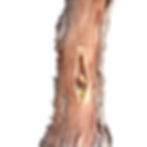Association "Les Vieilles Branches"
"Prenons nos Pieds en Mains. Trouver une solution naturelle au Phylloxéra."

Grafting and
Reconstitution
GRAFTING
Grafting involves unifying two living organisms, it consists in matching the cambium tissues of the scion (the aerial, fruit-bearing part) on to the rootstock (the root system) in order to obtain a biological bonding that unites them into a single individual.
In viticulture, it is usually a graft of Vitis vinifera which gives the aerial and fruit-bearing part of the new plant, and is implanted on an individual naturally resistant to Phylloxera, which supplies the root part of the new plant.
Many ancestral techniques were rehabilitated at the end of the 19th century.
Although the grafting of the vineyard has been known for several millennia, it has remained historically confidential, because the vine multiplies vegetatively wonderfully, by means of cuttings, marcottage or provignage.
The phylloxeric crisis and the Reconstitution were the universal promoters.
Various techniques have been known since Antiquity, such as grafts in full slot, lateral, patch, approach, Jupiter line, crown, inlay etc ... Simple or complicated English slot techniques date from the 17th century.
From the beginning of the Reconstitution, many machines were developed, which witnessed the cutting of the graft and sometimes the rootstock. The assembly is done by hand.
In the 1980s, new machines made it possible to completely mechanize grafting and produce what are called "grafted-welded" grafts.
Today, vine plants from the wine nursery are almost exclusively made from clonal plant material and assembled mechanically.






2. THE RECONSTITUTION
L. LALIMAN: Proposes the GRAFTING in 1869
At the Viticole Congress in Beaune in November 1869, L. Laliman, a winemaker and collector from Bordeaux, proposed GRAFTING as a response to evil : THE PHYLLOXERA. He had already experimented with the technique to fight against powdery mildew as early as in 1959: "By grafting our vines applied to strains of America, we will manage to fight powdery mildew vigorously. Neither powdery mildew nor vermin are to be feared with the American grape varieties, which one day be the golden goose of our winemakers". If his ambitious prognostications were not fully founded, there is no doubt that the genius L. Laliman deserves the recognition of the population of the "Americanists". However he was plagiarized, after being excommunicated (it was falsely claimed that he had introduced the Phylloxera).
G. BAZILLE: Paternity of the idea of grafting?
G. Bazille took ownership of the idea of grafting in order to resolve the conflict with the enemy : the aphid. This current was supported by passionate scientists and practitioners, including Victor Pulliat, who campaigned tirelessly, through lectures and courses, for grafting on resistant rootstocks, to renew the vineyard ravaged by the insect. Thus the current called "Americanist" arose and a wine movement, quite unique and immense in its scope, it was called the Reconstitution.
The indisputable benefit of grafting? It is generalizable.
This method of control against Phylloxera had the immense advantage, unlike the previous ones, of being absolutely generalizable to all vineyards, and accessible to humble winemakers.
So policies favoured this comfortable solution in the short term.
Transplant schools were created, and many winemakers were introduced to this easy access practice.
IMPACTS OF GRAFTING
Whatever the grafting technique used, it generates the formation of a seam of welding which necessarily changes the physiology and consequently the nutrition of the new plant.
The eminent biologist, Danielle Scheidecker, who specializes in plant grafting, explained the phenomenon in 1961 as follows: « The surgical intervention of grafting results in the formation of the scar seam. The anatomical structure of this bulge, which will largely determine its physiological role, varies considerably from graft to graft. »
It depends on the nature of the plants involved, but also on their age and stage of development at the time of the operation, as well as the grafting technique chosen» (“The transplant, its anatomical conditions, physiological consequences and possible genetic results”).
Thus, if the ancient vines could live multicentenarians (v. Bosc), with grafting, they saw their average life expectancy reduced to the simple century - our old vines testify to this.
With the creation and generalization of industrial and mechanized vine plants, in the 1980s, grafted-welded plants became real "consumables" whose average life expectancy is about thirty years.
